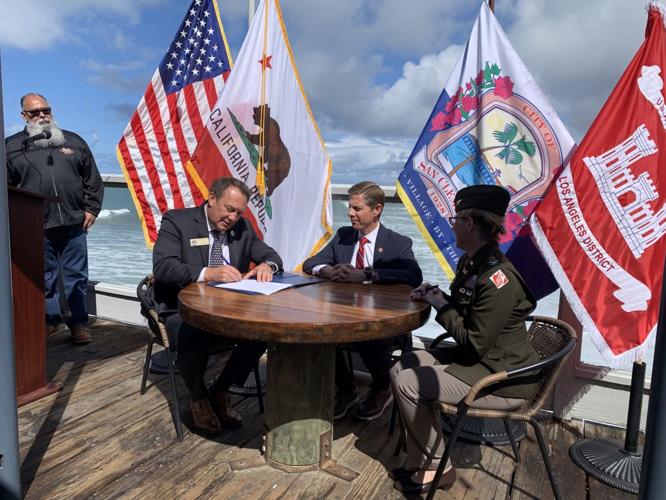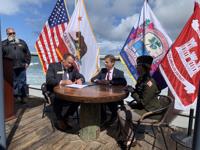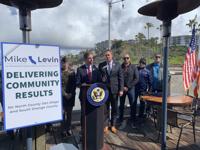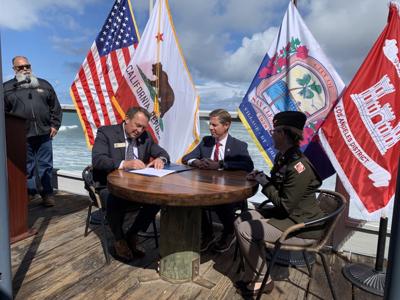Sitting at an outdoor patio table at the Fisherman’s Restaurant & Bar on Thursday morning, May 4, local and federal officials held a signing ceremony to memorialize an agreement to bring much-needed sand to San Clemente’s coastline.
The Project Partnership Agreement sets in motion the U.S. Army Corps of Engineers’ (USACE) commitment to the initial stage of the San Clemente Shoreline Project, which will put roughly 250,000 cubic yards of sand between Linda Lane and T-Street to widen the beach 50 feet.
Rep. Mike Levin, Mayor Chris Duncan, and Col. Julie Balten, commander of the USACE’s Los Angeles District, were on hand for the event Thursday.
The three spoke of the need to protect residential, commercial and municipal properties from wave action, in addition to protecting the Los Angeles-San Diego-San Luis Obispo (LOSSAN) Rail Corridor that carries a significant volume of freight and passengers.
“Fortunately, this project is designed to help address all of these issues by reducing the potential for storm damage to facilities located along the coast of San Clemente, including recreational beach facilities and the LOSSAN Rail Corridor, and helping restore and maintain recreational use around the San Clemente coastal area,” said Balten.
Duncan thanked Levin for his work in securing the $9.3 million that brought the 20-year effort closer to reality, community members for their assistance in the process, and laborers from the Laborers’ International Union of North America Local 652 group who will participate in fulfilling the project.
He reiterated the reliance San Clemente has on its beaches for entertainment and importance to local businesses, and mentioned the ongoing Nature Based Coastal Resiliency Project Feasibility Study, which seeks to find long-term sand retention solutions among other objectives.
Regarding the need to jumpstart projects that will bring sand to other depleted locations in the city, Levin affirmed its importance, saying such efforts up and down the coast of his district must be a “50-year commitment.”
Duncan added that completing the resiliency study and identifying how to best keep sand in place is a key step.
“Then, let’s (start) other sand replenishment projects, let’s think out of the box and look for partners like Congressman Levin and the federal government, who have shown they can get it done and deliver for us,” Duncan said.
At the San Clemente City Council’s meeting on Tuesday, May 2, Duncan and his colleagues heard a presentation from USACE’s Los Angeles District Project Manager Doland Cheung that detailed the upcoming project’s background, timeline and specifications.
The USACE authorized eight “renourishment events” to occur in approximately six-year intervals over a 50-year period in addition to the initial $15 million project, for which the federal government and the city split the cost into 65% and 35%, respectively.
Moving forward, the cost share will be 50-50 for the remaining $99.3 million needed to fulfill the entire plan.

Local and federal officials including San Clemente Mayor Chris Duncan and Rep. Mike Levin gather at the San Clemente Pier on Thursday, May 4, to officially set in motion the San Clemente Shoreline Project’s initial stage. Photo: C. Jayden Smith
Before the project’s estimated start in November or December, the Corps, Cheung said, is still waiting to receive state grant funding. The government agency must also confirm environmental commitments by mid-May, the city must obtain a California State Lands lease by June, and in July the USACE will award a contract to use the Portland District’s West Coast Hopper Dredge.
Once the dredging begins, a 75-foot-wide berth of sand, including 25 feet of “overbuild,” will be placed on the city beach to result in a beach that is actually 50 feet wide.
“The idea of that is that overbuild accommodates a thing called equilibration,” said Cheung. “What will happen is, quickly, that area will equalize to fill out the natural slope of the surrounding area.”
There will be a discharge area that is closed to the public, enforced by both temporary sand berms and fencing. Project operations will be limited to 7 a.m.-7 p.m.
In response to Councilmember Mark Enmeier questioning which way the sand will migrate, Cheung said the Corps expected movement to align with the traditional north-to-south plan.
“As the area starts to potentially erode again and go further south, you should see some of the south beaches picking up some of that material as it migrates down,” he said.
Kiel Koger, city engineer and director of public works, opined that the amount of rain Southern California experienced in recent months should contribute to an increase in sand on San Clemente beaches in the summer, as a significant amount of sediment was transferred.
Once the USACE completes the initial project, it will monitor the shoreline and include plans to fund the next nourishment cycle in the Corps’ budget as it determines the next necessary event.
Cheung couldn’t provide an estimate of what the cost would be according to price levels in the year of a specific cycle, but said updated cost estimates every two years will be helpful.





